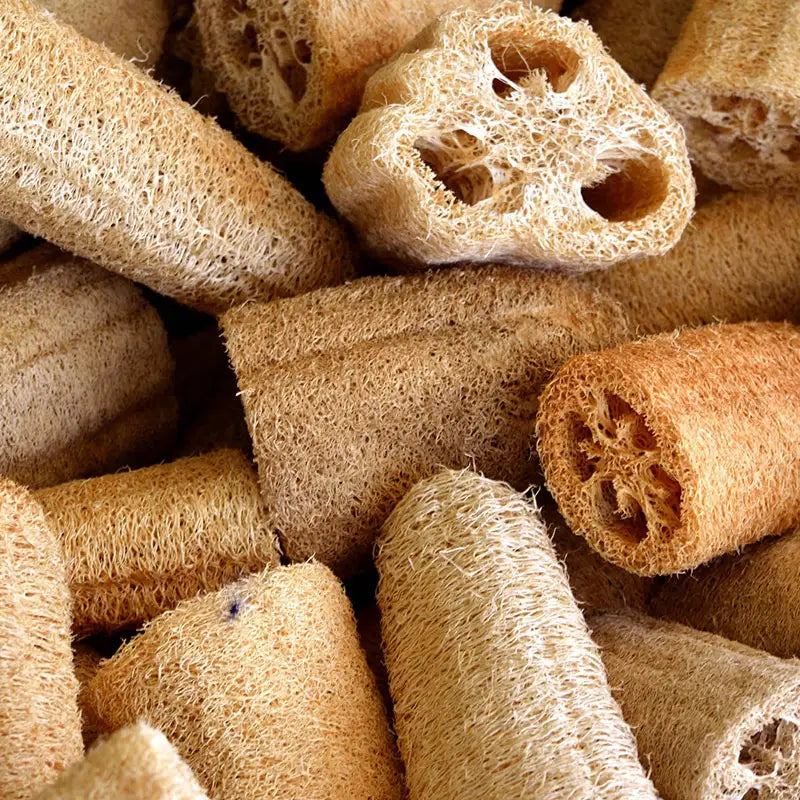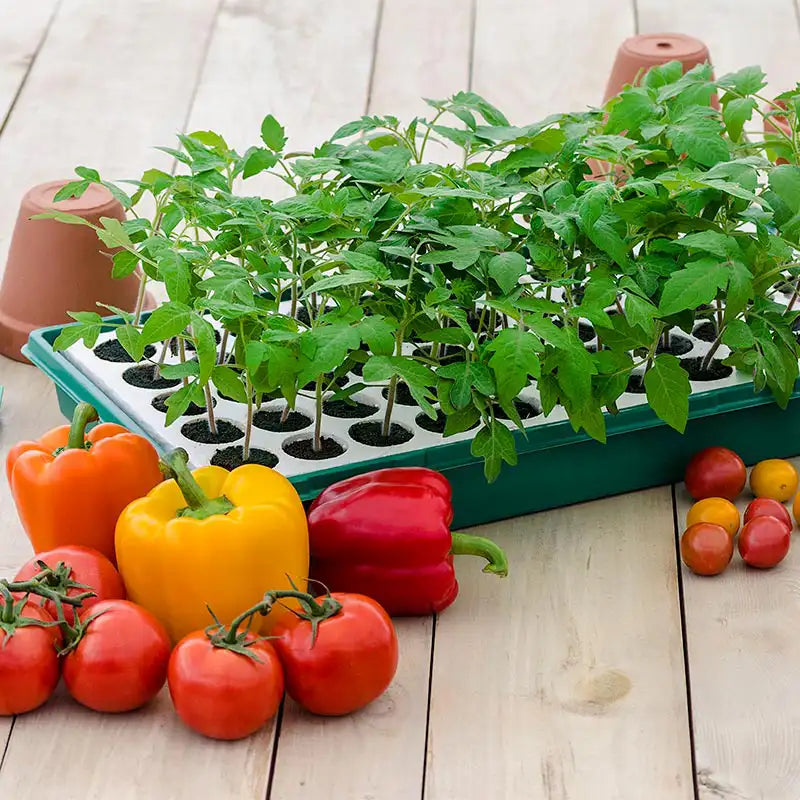What I have learned about Loofa Gourds
Q. Back in October we answered a question from Steve in Lancaster, PA, who wrote: "I have a friend who is going to try and grow a loofah plant and harvest the gourds for shower use. Is this a thing? Anything specific to know?"
A. In response, I told Steve that I was growing loofas myself this year, adding that yes, you can harvest an all-natural bath sponge from each gourd--if you do it right.
The Big Issue, I already knew, was Timing. Loofas take a long time to fully mature. My seed packet specified a maturity rate of 110 days, which is a long time, especially if it means 110 days after you move six-week-old transplants into warm soil--not 110 days from seed.
DTMs (Days to Maturity): For crops that are typically started indoors and then transplanted outside when they are six to eight weeks old (like peppers and tomatoes), the DTM clock doesn't start ticking until the transplant goes in the ground. My loofas were started from seed, so that means six extra weeks to get to those 110 days, which adds up to 150 or so days before you can harvest a gourd that has a chance of becoming a sponge.
For long-season crops like loofas, you have to be realistic about how many growing days you can actually provide.
The National Gardening Association says the growing season in Lancaster (about 50 miles west of my garden) begins on April 15th and runs through October 21st for a non-realistic total of 190 days. I wish.
This year, late frosts delayed planting tender crops like tomatoes, peppers, and yes, loofas until early June in our area. And the hours of daylight get markedly shorter beginning around June 22nd. In mid-Atlantic gardens, survival is your best hope in October, as the plants were pretty much done actual growing around mid-September.
The task, of course, is a lot easier for gardeners in USDA Zone 7 and warmer. But trying this in a lower zone requires a lot of strategizing.
Preface over. Here's what happened to my loofas this year:
I started the loofa seeds (along with my peppers and tomatoes) in mid-March. All went well for a couple of weeks. Then I {quote} "noticed" that the vines had grown rapidly and were close to strangling my tiny little pepper seedlings with their tendrils of death. Heck, they were strangling everything with their Godzilla-like growth. It took a full day to untangle this horticultural nightmare. Then I moved the two strongest pots of loofas into their own corner, where their tendrils started chasing the cat.
That's lesson #1: Don't start overly aggressive vines near other plants or delicate objects. I encourage our Lancaster gardener to utilize a trick I thought of way too late: start them in large pots in which you have inserted tomato cages, giving them something to do instead of murdering other plants.
When it came time to finally move them outside, I didn't want to chance planting them in their garden, where their homicidal tentacles could roam free. Instead, I planted them--pots and all--in a raised bed on legs on my patio, where their roots quickly burst open the pots and the voracious vines climbed up a two-story wall and onto the roof.
It seemed to take forever to get female flowers, but eventually three gourds appeared in August. One gourd was long and skinny, like a green zeppelin; another had a pear shape; and the third was bulbously full top to bottom. As September marched on, I was worried that they were still green. To harvest usable sponges, you're supposed to let them stay on the vine until the outer shell turns brown and you can hear seeds rattling inside. That's when I realized that most of the websites I had been using for advice were based in Southern California (where they estimated a desirable DTM of 200 days).
Blind panic. Nights were already dipping into the low 50s and we had already moved the pepper plants inside to hopefully overwinter and stripped the tomato plants of their fruits. (It was a very good year for tomatoes, BTW.)
But what to do with the loofas? No sources had any advice on harvesting greenies, but they all said to bring them in before frost, which I failed to do. Oh no! My first garden failure! {ahem}
Pumpkins and some other squash will continue to ripen indoors under the right conditions (which I had already avoided by letting them get frosted), so we laid them out to dry in the kitchen and lit a pumpkin spice candle (easy to find at that time of year) for good luck. Eventually, little spots of mold began to appear, which everybody agreed was a major no-no, so we bit the bullet and peeled them.
Miraculously, all three produced sponges! We rinsed them several times and then sat them on top of a multi-layer dehydrator to hasten the drying. After a few days, they were done, and shaking them produced ripe seeds. Success! (Who'd a thunk it?)
Photos of my three sponges have appeared on the You Bet Your Garden Facebook page and will magically reappear this weekend.
And no; I do NOT plan on growing them again!
A. In response, I told Steve that I was growing loofas myself this year, adding that yes, you can harvest an all-natural bath sponge from each gourd--if you do it right.
The Big Issue, I already knew, was Timing. Loofas take a long time to fully mature. My seed packet specified a maturity rate of 110 days, which is a long time, especially if it means 110 days after you move six-week-old transplants into warm soil--not 110 days from seed.
DTMs (Days to Maturity): For crops that are typically started indoors and then transplanted outside when they are six to eight weeks old (like peppers and tomatoes), the DTM clock doesn't start ticking until the transplant goes in the ground. My loofas were started from seed, so that means six extra weeks to get to those 110 days, which adds up to 150 or so days before you can harvest a gourd that has a chance of becoming a sponge.
For long-season crops like loofas, you have to be realistic about how many growing days you can actually provide.
The National Gardening Association says the growing season in Lancaster (about 50 miles west of my garden) begins on April 15th and runs through October 21st for a non-realistic total of 190 days. I wish.
This year, late frosts delayed planting tender crops like tomatoes, peppers, and yes, loofas until early June in our area. And the hours of daylight get markedly shorter beginning around June 22nd. In mid-Atlantic gardens, survival is your best hope in October, as the plants were pretty much done actual growing around mid-September.
The task, of course, is a lot easier for gardeners in USDA Zone 7 and warmer. But trying this in a lower zone requires a lot of strategizing.
Preface over. Here's what happened to my loofas this year:
I started the loofa seeds (along with my peppers and tomatoes) in mid-March. All went well for a couple of weeks. Then I {quote} "noticed" that the vines had grown rapidly and were close to strangling my tiny little pepper seedlings with their tendrils of death. Heck, they were strangling everything with their Godzilla-like growth. It took a full day to untangle this horticultural nightmare. Then I moved the two strongest pots of loofas into their own corner, where their tendrils started chasing the cat.
That's lesson #1: Don't start overly aggressive vines near other plants or delicate objects. I encourage our Lancaster gardener to utilize a trick I thought of way too late: start them in large pots in which you have inserted tomato cages, giving them something to do instead of murdering other plants.
When it came time to finally move them outside, I didn't want to chance planting them in their garden, where their homicidal tentacles could roam free. Instead, I planted them--pots and all--in a raised bed on legs on my patio, where their roots quickly burst open the pots and the voracious vines climbed up a two-story wall and onto the roof.
It seemed to take forever to get female flowers, but eventually three gourds appeared in August. One gourd was long and skinny, like a green zeppelin; another had a pear shape; and the third was bulbously full top to bottom. As September marched on, I was worried that they were still green. To harvest usable sponges, you're supposed to let them stay on the vine until the outer shell turns brown and you can hear seeds rattling inside. That's when I realized that most of the websites I had been using for advice were based in Southern California (where they estimated a desirable DTM of 200 days).
Blind panic. Nights were already dipping into the low 50s and we had already moved the pepper plants inside to hopefully overwinter and stripped the tomato plants of their fruits. (It was a very good year for tomatoes, BTW.)
But what to do with the loofas? No sources had any advice on harvesting greenies, but they all said to bring them in before frost, which I failed to do. Oh no! My first garden failure! {ahem}
Pumpkins and some other squash will continue to ripen indoors under the right conditions (which I had already avoided by letting them get frosted), so we laid them out to dry in the kitchen and lit a pumpkin spice candle (easy to find at that time of year) for good luck. Eventually, little spots of mold began to appear, which everybody agreed was a major no-no, so we bit the bullet and peeled them.
Miraculously, all three produced sponges! We rinsed them several times and then sat them on top of a multi-layer dehydrator to hasten the drying. After a few days, they were done, and shaking them produced ripe seeds. Success! (Who'd a thunk it?)
Photos of my three sponges have appeared on the You Bet Your Garden Facebook page and will magically reappear this weekend.
And no; I do NOT plan on growing them again!



